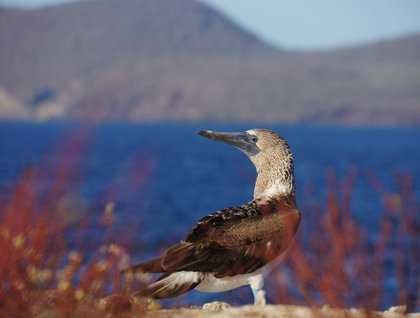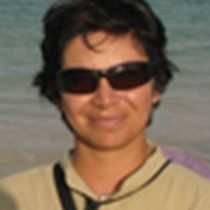We left the western islands and their beautiful shield volcanoes and navigated towards Santiago, also known as James Island. Early in the morning we dropped anchor at Espumilla beach, northwest of the island. The sand of this beach has a pink tinge, and it is surrounded by beautiful mangrove trees. Pacific green sea turtles come to this beach to lay their eggs, and behind it there is a trail, which we followed to reach a higher slope from which the bay is visible. We crossed a forest of old and majestic palo santo or incense trees, and ventured through dense mangroves to return back to the beach. The place has a timeless beauty; it looks the same as when buccaneers and privates visited Santiago some 250 years ago. We returned to the ship for breakfast and to prepare for the next activities in the morning.
Nearby lies Buccaneer Cove, a historic place where once a young naturalist named Charles Darwin landed in order to explore the island and its lava flows. The cove has stunning cliffs, some very tall others quite eroded by wind and waves. The waters here are extremely rich since they are still reached by cold currents. We were able to see great numbers of marine life that occurs here, viewed from the comfort of the glass-bottom boat. The variety of fish species was great: from the common razor surgeonfish to the barber fish, various species of parrot fish, grunts, cabrillas, and puffers. A lonely male sea lion hunted some black-striped salemas, oblivious to our presence. The snorkelers had a fantastic time in the clear and warm water; they had a chance to swim with the large schools of fish, spotted rays, and eels, and simply enjoy the wonderful underwater world of Buccaneer Cove. Others kayaked along the shoreline, which is the home to many seabirds like Nazca and blue-footed boobies, brown noddy terns, and herons.
In the afternoon we changed anchorage and stopped at James Bay. Here lie the remains of some buildings, last reminders of the small settlement named Puerto Egas. Dismantled in the 1970s, the entire island is now part of the natural areas of the Galápagos National Park. We disembarked at the black beach of Puerto Egas, where some of our guests decided to stay to simply enjoy and relax in the sand and waves. Most preferred to make their way along the path behind the beach leading to the coast of Puerto Egas. We could never expect the amazing wildlife that was there, as if waiting for us: there were numbers of marine iguanas, sunbathing in the warm afternoon sun; dozens of sea lion pups played or slept rather placidly on the soft tuff rocks. Bright red Sally Lightfoot crabs decorated the pahoehoe lavas; various migratory birds fed on the abundant invertebrates of the intertidal zone. Several Galápagos hawks contemplated the scene from the top of the palo santo trees, and the endemic Galápagos fur sea lions seemed to be content at just relaxing on the rocks by the stunning natural grottos or in the water. In the distance, we could observe a fantastic feeding frenzy of brown noddies, blue-footed boobies, and pelicans in huge numbers chasing a school of small fish. The golden light of the sunset suddenly bathed the slopes of Isabela, Fernandina, and Santiago… With such fantastic colors surrounding us, we can certainly say that this will be one of the most unforgettable days in the Enchanted Isles.







